Description
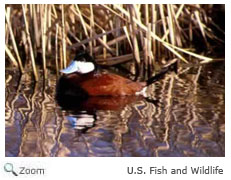 The ruddy duck is a small, stocky diving duck 14-17 inches in length with a wingspan of
22-24 inches. It has short, stubby wings and a long, stiff tail that it often holds straight up. The male has a
chestnut
body; a black crown; a white face; and a wide, bright blue bill. The female is grayish-brown with grayish-white cheeks with a black line running across the side of her face. When it is not breeding season, the male looks similar to the female, and his bill turns grayish-black. The ruddy duck is a small, stocky diving duck 14-17 inches in length with a wingspan of
22-24 inches. It has short, stubby wings and a long, stiff tail that it often holds straight up. The male has a
chestnut
body; a black crown; a white face; and a wide, bright blue bill. The female is grayish-brown with grayish-white cheeks with a black line running across the side of her face. When it is not breeding season, the male looks similar to the female, and his bill turns grayish-black.
Range 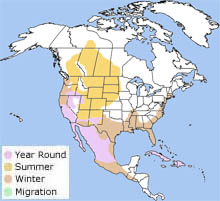 The ruddy duck is found along the Pacific, Gulf, and Atlantic Coasts north to British Columbia , Canada on the west coast, and Massachusetts on the east coast. It is also found inland to Missouri from the Gulf Coast. The ruddy duck has also been
introduced to Great Britain. The ruddy duck is found along the Pacific, Gulf, and Atlantic Coasts north to British Columbia , Canada on the west coast, and Massachusetts on the east coast. It is also found inland to Missouri from the Gulf Coast. The ruddy duck has also been
introduced to Great Britain.
Habitat
The ruddy duck
breeds on freshwater and
alkaline
marshes, lakes, and ponds and winters on marshes and in shallow coastal bays.
|
|
Diet
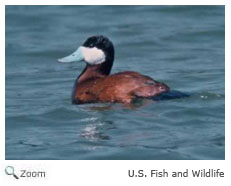 The ruddy duck is a diving duck and eats
insects,
insect larvae, snails, mollusks, seeds, and the roots of aquatic plants.
It
uses its broad bill to strain food from both the bottom mud and the surface of the water. It sinks into the water slowly instead of diving straight down like other diving ducks. The ruddy duck is a diving duck and eats
insects,
insect larvae, snails, mollusks, seeds, and the roots of aquatic plants.
It
uses its broad bill to strain food from both the bottom mud and the surface of the water. It sinks into the water slowly instead of diving straight down like other diving ducks.
Life Cycle
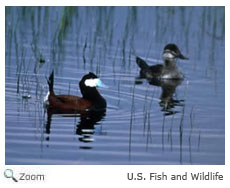 The male ruddy duck courts the female by fanning out his tail, beating his bill against his chest to make a drumming sound, and creating bubbles in the water. The female lays 6-20 eggs
a floating nest of dry stems lined with down that is concealed among reeds or bulrushes in a marsh.
The male
usually leaves the female when she starts to incubate the eggs.
The female incubates the eggs for 23-28 days. The ducklings usually stay with their mother and follow her during feeding until they fledge at 43-48 days.
The female sometimes lays her eggs in the nests of other ducks. The male ruddy duck courts the female by fanning out his tail, beating his bill against his chest to make a drumming sound, and creating bubbles in the water. The female lays 6-20 eggs
a floating nest of dry stems lined with down that is concealed among reeds or bulrushes in a marsh.
The male
usually leaves the female when she starts to incubate the eggs.
The female incubates the eggs for 23-28 days. The ducklings usually stay with their mother and follow her during feeding until they fledge at 43-48 days.
The female sometimes lays her eggs in the nests of other ducks.
Behavior
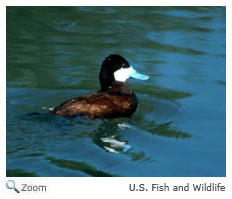 The ruddy duck often dives underwater or swims away from danger instead of flying away. It has to run across the surface of the water in order to build up enough speed to take off in flight. Once it is in the air, it has to flap its wings very fast to stay in the air. The ruddy duck often dives underwater or swims away from danger instead of flying away. It has to run across the surface of the water in order to build up enough speed to take off in flight. Once it is in the air, it has to flap its wings very fast to stay in the air.
|



 The ruddy duck is found along the Pacific, Gulf, and Atlantic Coasts north to British Columbia , Canada on the west coast, and Massachusetts on the east coast. It is also found inland to Missouri from the Gulf Coast. The ruddy duck has also been
introduced to Great Britain.
The ruddy duck is found along the Pacific, Gulf, and Atlantic Coasts north to British Columbia , Canada on the west coast, and Massachusetts on the east coast. It is also found inland to Missouri from the Gulf Coast. The ruddy duck has also been
introduced to Great Britain.


